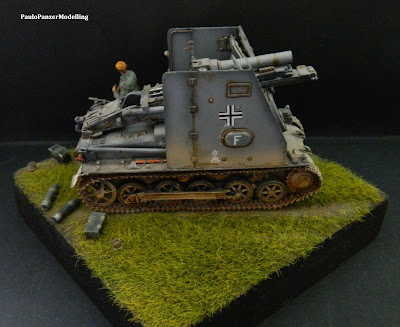Bonjour,
Je vous présente aujourd'hui un petit char sympa et assez original pour une collection de blindés. Le Bison Sig33 sur Panzer1.
En févriers 1940, la firme Almarkische Kettenwerk afin de motoriser un obusier Sig33, recycle des châssis de Panzer1. Muni d'un blindage de 10mm protégeant les hommes de la bataille , le panzer1 est inadapté pour ce type de canon. Toue la place est occupé par l'obusier, la dotation en munitions sont limités, donc un transport de munitions est nécessaire. Le artilleurs devient descendre la pièce de 15cm pour tirer avec, mais en combat , la pièce d'artillerie resté sur le blindé, pourtant déconseillé.
Ce char est de marque Alan qui a disparu depuis quelque années. Question da la qualité, très difficiles à monter surtout les chenilles. peinture en gris panzer, couleur de base pour les chars allemands avant 1943.
La scénette représente une reddition des artilleurs au premier jours de l'offensive de Barbarossa 1941 sur le front de l'est.
Voici les photos
Good morning,
I present you today a nice little tank and quite original for a collection of tanks. The Bison Sig33 on Panzer1.
In February 1940, the firm Almarkische Kettenwerk to power a Sig33 howitzer, recycles Panzer chassis. Equipped with a 10mm armor protecting men from battle, the panzer 1 is unsuitable for this type of cannon. All the place is occupied by the howitzer, ammunition supply is limited, so transport of ammunition is necessary. The gunners become down the piece of 15cm to shoot with, but in combat , the piece of artillery remained on the armored, yet discouraged.
This tank is Alan brand which disappeared for some years. Question da quality, very difficult to assemble especially the tracks. Panzer grey paint, basic color for German tanks before 1943.
The scene depicts a surrender of the gunners in the first days of the 1941 Barbarossa offensive on the eastern front.
Here are the photos









